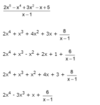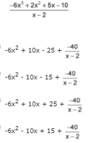Module 02: Polynomial and Rational Functions Flashcards
(73 cards)
Find the vertex of the graph of the function.
f(x) = (x + 4)2 + 4 (2 points)
- (0, -4)
- (4, 0)
- (4, -4)
- (-4, 4)
4. (-4, 4)
Find the vertex of the graph of the function.
f(x) = 2x2 + 8x + 10 (2 points)
- (3, -1)
- (2, -2)
- (-2, 2)
- (-1, 3)
3. (-2, 2)
Write the quadratic function in vertex form.
y = x2 + 8x + 18
y = (x + 4)2 + 2
A projectile is thrown upward so that its distance above the ground after t seconds is given by the function h(t) = -16t2 + 704t. After how many seconds does the projectile take to reach its maximum height? Show your work for full credit. (2 points)
The projectile will take 22 seconds (t) to reach its maximum height at 7744.
Find the zeros of the function.
f(x) = 9x2 - 27x + 20
- 5 and 4
- -5 and -4
- -5/3 and -4/3
- 5/3 and 4/3
4. 5/3 and 4/3
Find the zeros of the function.
f(x) = 9x3 - 45x2 + 36x (2 points)
- 0, 1, and 4
- -1 and -4
- 1 and 4
- 0, -1, and -4
- 0, 1, and 4
Find the zeros of the polynomial function and state the multiplicity of each.
f(x) = 4(x + 7)2(x - 7)3
- 4, multiplicity 1; -7, multiplicity 3; 7, multiplicity 3
- -7, multiplicity 3; 7, multiplicity 2
- 4, multiplicity 1; 7, multiplicity 1; -7, multiplicity 1
- -7, multiplicity 2; 7, multiplicity 3
4. -7, multiplicity 2; 7, multiplicity 3
Find a cubic function with the given zeros. (2 points)
√2 , -√2 , -2
- f(x) = x3 + 2x2 - 2x + 4
- f(x) = x3 +2x2+ 2x - 4
- f(x) = x3 - 2x2 - 2x - 4
- f(x) = x3 + 2x2 - 2x - 4
4. f(x) = x3 + 2x2 - 2x - 4
Expand the following using either the Binomial Theorem or Pascal’s Triangle. You must show your work for credit.
(x - 5)5
See attachment

Divide using synthetic division, and write a summary statement in fraction form. (2 points)

Answer: 3
Divide f(x) by d(x), and write a summary statement in the form indicated.
f(x) = x4 + 4x3 + 6x2 + 4x + 5; d(x) = x2 + 1
- f(x) = (x2 + 1)( x2 + 4x + 5) + 12x - 15
- f(x) = (x2 + 1)( x2 + 4x + 5)
- f(x) = (x2 + 1)( x2 - 4x + 5)
- f(x) = (x2 + 1)( x2 - 4x + 5) + 12x - 15
2. f(x) = (x2 + 1)( x2 + 4x + 5)
Find the remainder when f(x) is divided by (x - k).
f(x) = 3x3 - 4x2 - 3x + 14; k= 3
- 50
- 68
- -12
- 112
50
Use synthetic division to determine whether the number k is an upper or lower bound (as specified) for the real zeros of the function f.
k = -1; f(x) = 4x3 - 2x2 + 2x + 4; Lower bound?
YES or NO
YES
Use the Rational Zeros Theorem to write a list of all possible rational zeros of the function.
f(x) = 2x3 + 8x2 + 7x - 8
According to the Rational Zeros Theorem, p is the factors of the constant term of a0, which is 8. Therefore, p = 1, 2, 4, 8. Next, q is the leading coefficient of an, which is 2, so the factors of q are 1 and 2. According to the Rational Zeros Theorem, the possible zeros is p/q.

Write the sum or difference in the standard form a + bi. (2 points)
( 7 + 5i) - ( -9 + i)
- 16 + 4i
- -16 - 4i
- 16 - 4i
- -2 + 6i
- 16 + 4i
Write the product in standard form. (2 points)
( 4 + 7i)( 7 + 7i)
-21 + 77i
Find the product of the complex number and its conjugate
1 + 3i
- 1 + 9i
- 10
- -8
- 1 - 9i
2. 10
Write the expression in standard form:
3/ (3-12i)
1/17 + 4/17i
Find the real numbers x and y that make the equation true
-4 + yi = x + 3i
According to the Rule of Equality of Complex Numbers, a+bi=c+di, only if a=c and b=d. Therefore, in order for the above equation to be equal, x=-4 and y=3.
Write a polynomial function of minimum degree with real coefficients whose zeros include those listed. Write the polynomial in standard form. (2 points)
4, -8, and 2 + 5i
f(x) = x4 - 19x2 + 244x - 928
State how many imaginary and real zeros the function has. (3 points)
f(x) = x3 + 5x2 + x + 5
- 0 imaginary; 3 real
- 1 imaginary; 2 real
- 3 imaginary; 0 real
- 2 imaginary; 1 real
4. 2 imaginary; 1 real
Write a linear factorization of the function.
f(x) = x4 + 64x2
f(x) = x2(x + 8i)(x - 8i)
State the domain of the rational function. (2 points)
f(x) = 13/ (10-x)
- All real numbers except -10 and 10
- All real numbers except 13
- All real numbers except 10
- All real numbers except -13 and 13
3. All real numbers except 10
State the vertical asymptote of the rational function. (2 points)
f(x) = [(x-6)(x+6)] / (x2-9)
x = 3, x = -3










